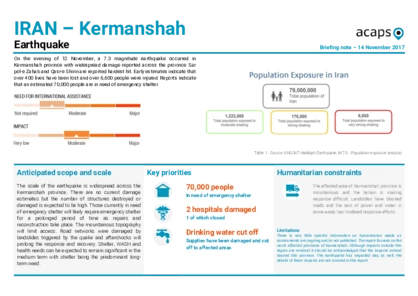Latest updates on country situation
11 November 2025
Iran is facing a severe drought crisis, with water reservoirs supplying Tehran (with a population of ten million) dropping to 8–11% of capacity, raising fears that the city could run out of safe drinking water within weeks. By 8 November 2025, authorities were planning intermittent water cuts, likely forcing low-income households to rely on unsafe water sources. Continued drought and water scarcity are causing significant health risks. Power outages resulting from water shortages can affect medical facilities, causing medicine and vaccine refrigeration issues and aggravating healthcare disruptions. The water shortages disproportionally affect women, who are traditionally tasked to handle childcare, elder care, cooking, and hygiene. They must manage daily water needs during long outages, queue at water tankers, and handle rising costs, which can lead to mental health issues. The intersection of water shortages, economic inflation, and drought-triggered disruptions is deepening needs, increasing social unrest risks and potentially driving displacement. (BBC 10/11/2025,
France 24 08/11/2025, WNCRI 12/10/2025)
20 May 2025
Since 20 March 2025, more than 242,800 Afghans have returned to Afghanistan from Iran following the Iranian Government’s deadline for extending headcount slips. These mass returns are occurring amid an already deteriorating humanitarian situation in Afghanistan, where returnees face critical challenges upon arrival. In April alone, more than 251,000 Afghans returned from Pakistan and Iran, including more than 96,000 deported. Most lack adequate shelter, income, access to food, clean water, and healthcare. By May 2024, almost 87% of returnee households required housing assistance, 80% needed financial support, and 71% lacked sufficient food. New arrivals are likely to encounter similar hardships. Many families live in informal camps or overcrowded shelters with limited services. The healthcare system faces challenges, and access to education, especially for returnee children and women, is limited. Employment opportunities are scarce, especially for those without documentation, aggravated by the economic crisis. (UNHCR 13/05/2025, UNHCR 29/04/2025, UNHCR 28/05/2024)
03 April 2023
The situation for Afghan refugees in Iran is becoming increasingly difficult. Since January 2023, over 250,000 refugees returned to Afghanistan from Iran, at least half of them facing some form of coercion. Displaced Afghan people face protection risks, including family separation, violence, and persecution. The situation is particularly unpredictable for undocumented people, who have limited access to services. The process of renewing documentation for refugees has also become more complicated, putting documented refugees at risk of becoming undocumented. Access to education has been impeded by the lack of documentation, affordability, and child labour. The situation is compounded by the political and economic situation in Iran, where social unrest and inflation (64% in March 2023) are making it difficult for refugees to meet their basic needs. Limited livelihood opportunities and restricted access to employment have lowered purchasing power and increased protection risks from negative coping strategies. Afghan refugees in Iran face discrimination and growing resentment caused by economic pressure and perceived competition for jobs. Despite Iran's history of being inclusive to refugees, recent reports show the mistreatment towards Afghan refugees by both government officials and civilians, including physical abuse and wrongful detention. (IOM 19/04/2023, UNHCR 09/03/2023, EU 11/01/2023, The Khaama Press 27/03/2023, Iran International 02/04/2023)
current crises
in
Iran
These crises have been identified through the INFORM Severity Index, a tool for measuring and comparing the severity of humanitarian crises globally.
IRN004 - Displacement from Afghanistan
Last updated 28/11/2025
Drivers
International Displacement
Crisis level
Country
Severity level
3.9 High
Access constraints
4.0
Analysis products
on
Iran
14 November 2017
Iran: Earthquake in Kermanshah
DOCUMENT / PDF / 525 KB
On the evening of 12 November, a 7.3 magnitude earthquake occurred in Kermanshah province with widespread damage reported across the province. Sar pol-e Zahab and Qasr-e Shirin are reported hardest hit. Early estimates indicate that over 400 lives have been lost and over 6,600 people were injured. Reports indicate that an estimated 70,000 people are in need of emergency shelter.


